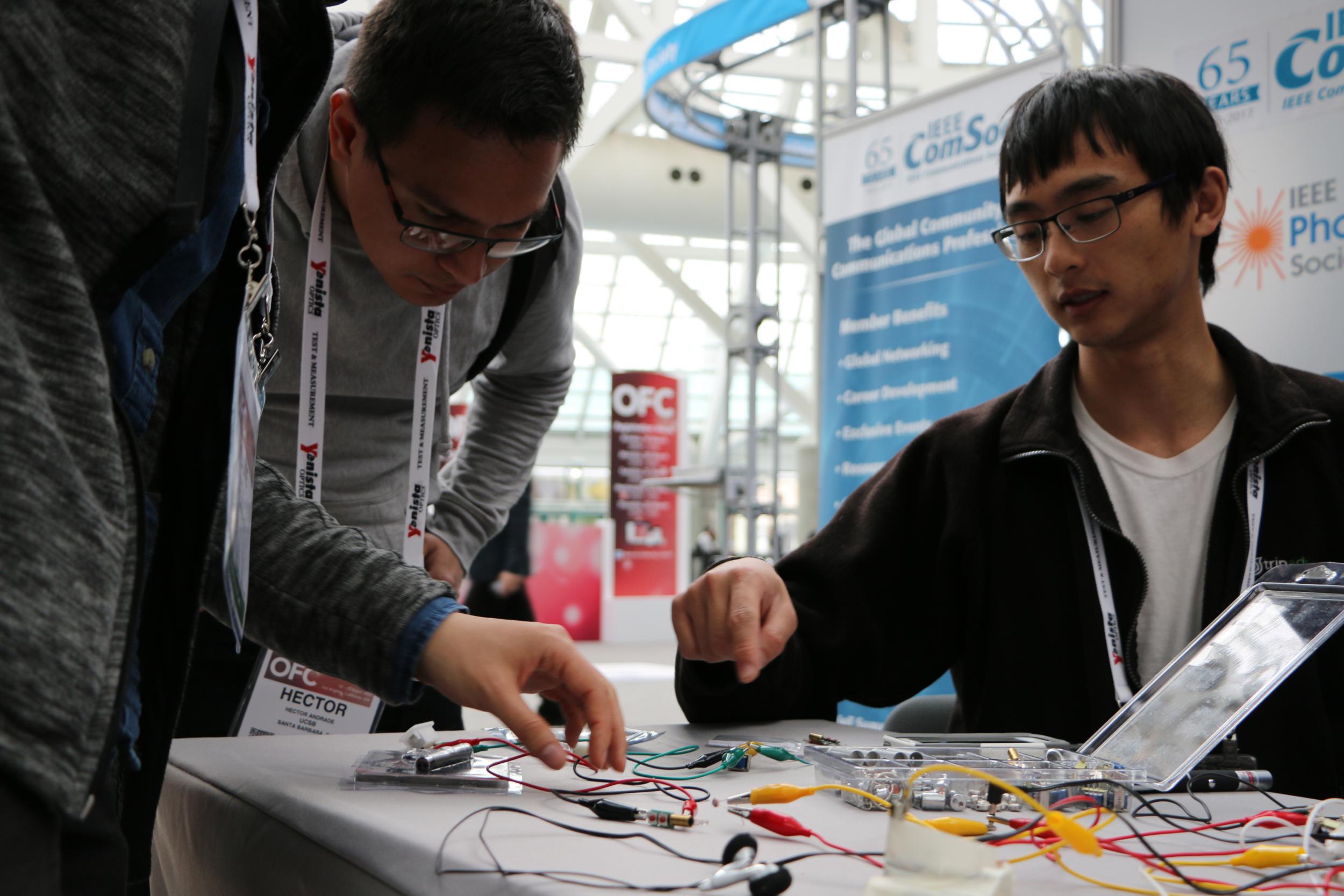The UCSB IEEE Photonics Society Holds STEM Outreach Demo at OFC Conference 2017

On Tuesday March 21st, graduate students from the UCSB Student Chapter of the IEEE Photonics Society hosted a demo table at the 2017 OFC “optical fiber communications” conference in Los Angeles. The group brought 3 hands-on demos that had been developed for after-school science nights and high-school classes through UCSB programs such as CSEP’s FUSE and SST programs, funded by AIM and IPS.
Each activity was intended to explain a different aspect of how we use light in our daily lives. Conference attendees, already deeply familiar with light-based technologies, were encouraged to use these activities or design their own activities for use in their local schools.
 The “Light-Pipes: Controlling Light” hands-on activity guided attendees through the exercise of teaching a student (8th grade) how we can manipulate light and use it to send messages. Beginning with a laser being bounced around inside a water tank, to Morse code down cheap plastic optical fibers, the activity culminates with a “gelatin waveguide”, challenging students and conference attendees to use gelatin to trap laser light and bend it around 180. This demo for conference attendees was particularly relevant to the “Optical Fiber Communications” conference, and the full activity was deployed to 5 local Santa Barbara junior high schools in 2016.
The “Light-Pipes: Controlling Light” hands-on activity guided attendees through the exercise of teaching a student (8th grade) how we can manipulate light and use it to send messages. Beginning with a laser being bounced around inside a water tank, to Morse code down cheap plastic optical fibers, the activity culminates with a “gelatin waveguide”, challenging students and conference attendees to use gelatin to trap laser light and bend it around 180. This demo for conference attendees was particularly relevant to the “Optical Fiber Communications” conference, and the full activity was deployed to 5 local Santa Barbara junior high schools in 2016.
The “Color Mixing” activity posed the question of how a printer can use only three colors to reproduce every visible color, and why these strange Cyan, Magenta and Yellow choices for those three colors? Conference attendees were fascinated by the fact that we can “trick” the brain into seeing every color based on the way the human eye works, and how we do that using only three colors. This activity is currently being deployed at 4 Santa Barbara and Goleta schools throughout 2017.
 The “Laser Communications” activity was developed for a 5-week course for selected high-school students, taught by UCSB Graduate Students. The activity led students through building a simple circuit to transmit music from their smartphone through airborne laser pulses, and receive the data on a detector to be played on headphones. Attendees particularly enjoyed this activity due to the fact that so-called “free-space laser communications” is an active research area, being spearheaded by NASA and commercial companies around the world, and this is a fun way to introduce the idea to high-school students.
The “Laser Communications” activity was developed for a 5-week course for selected high-school students, taught by UCSB Graduate Students. The activity led students through building a simple circuit to transmit music from their smartphone through airborne laser pulses, and receive the data on a detector to be played on headphones. Attendees particularly enjoyed this activity due to the fact that so-called “free-space laser communications” is an active research area, being spearheaded by NASA and commercial companies around the world, and this is a fun way to introduce the idea to high-school students.
Demis D. John - industry@ips.ece.ucsb.edu